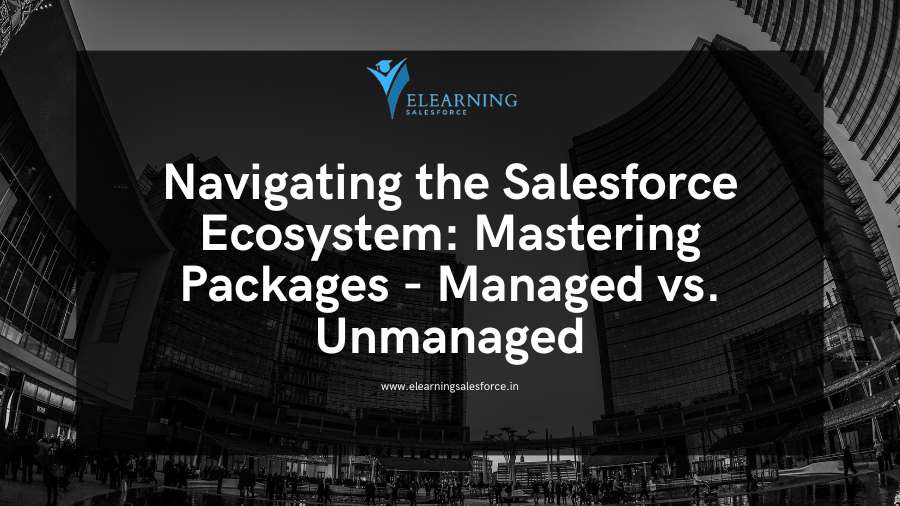Introduction: Salesforce Packages
Salesforce, a trailblazer in cloud-based customer relationship management (CRM), empowers businesses to transform their operations and enhance customer experiences. One of the key features that make Salesforce highly adaptable is its packaging system. Salesforce packages allow developers and administrators to bundle and distribute components, providing a streamlined approach to customizing and extending the platform. In this blog, we’ll delve into the world of Salesforce packages, exploring the differences between managed and unmanaged packages and helping you make informed choices for your Salesforce implementation.
Understanding Salesforce Packages:
Salesforce packages are containers that bundle together metadata components such as custom objects, fields, workflows, and more. These packages facilitate the seamless deployment of customizations, ensuring consistency across different environments and orgs. Two primary types of packages exist within the Salesforce ecosystem: managed packages and unmanaged packages.
Unmanaged Packages:
- Overview:Unmanaged packages are a straightforward way to distribute customizations without the complexities associated with versioning and upgrades. Components in unmanaged packages are directly accessible and modifiable in the destination org.
- Characteristics:
- Open Access: All components in an unmanaged package are open and editable in the destination org, providing flexibility but potentially leading to unintended changes.
- No Versioning: Unmanaged packages do not support versioning. Any changes made to the package need to be manually tracked and updated in each org.
- Direct Modifications: Components can be modified directly in the destination org, making it easy to adapt customizations on a per-org basis.
- Use Cases:
- Project Development: Unmanaged packages are often used during the initial stages of development when customization requirements are evolving rapidly.
- Single Org Customizations: Ideal for making one-time customizations in a specific org without the need for version control.
Managed Packages:
- Overview:Managed packages are designed for distribution on the Salesforce AppExchange or across multiple orgs. Components in a managed package are protected, providing a controlled and upgradable solution.
- Characteristics:
- Locked Components: Components in a managed package are locked, preventing direct modifications in the destination org. Users can only make changes through upgrades or patches.
- Versioning Support: Managed packages support versioning, allowing developers to release updates with new features, bug fixes, and enhancements.
- License Management: Managed packages enable the implementation of licensing and permissions, offering control over who can access and modify the packaged components.
- Use Cases:
- AppExchange Distribution: Managed packages are essential for developers creating apps for distribution on the Salesforce AppExchange.
- Multi-Org Deployments: Ideal for organizations with multiple Salesforce orgs where consistent, upgradable customizations are required.
- ISV Solutions: Independent Software Vendors (ISVs) often use managed packages to deliver scalable and maintainable solutions to their customers.
Making the Right Choice:
When to Use Unmanaged Packages:
- Initial Development:During the early stages of development when customization requirements are evolving rapidly and flexibility is crucial.
- Single Org Customizations:For making one-time customizations in a specific org without the need for version control.
- Quick Iterations:When quick iterations and direct modifications in the destination org are preferred.
When to Use Managed Packages:
- AppExchange Distribution:If you intend to distribute your application or solution on the Salesforce AppExchange.
- Version Control:When versioning is crucial for maintaining and updating customizations across multiple orgs.
- License Management:For scenarios where you need control over who can access and modify the packaged components.
- ISV Solutions:If you are an Independent Software Vendor providing solutions to multiple Salesforce orgs.
Conclusion:
Salesforce packages play a pivotal role in the customization and extension of the Salesforce platform. Understanding the distinctions between managed and unmanaged packages is essential for making informed decisions based on your organization’s specific needs. Whether you opt for the flexibility of unmanaged packages during initial development or the control and scalability of managed packages for distribution and versioning, mastering Salesforce packages empowers you to harness the full potential of the Salesforce ecosystem. As you embark on your Salesforce journey, consider the nuances of each package type to tailor your approach and drive success in your Salesforce implementation.
